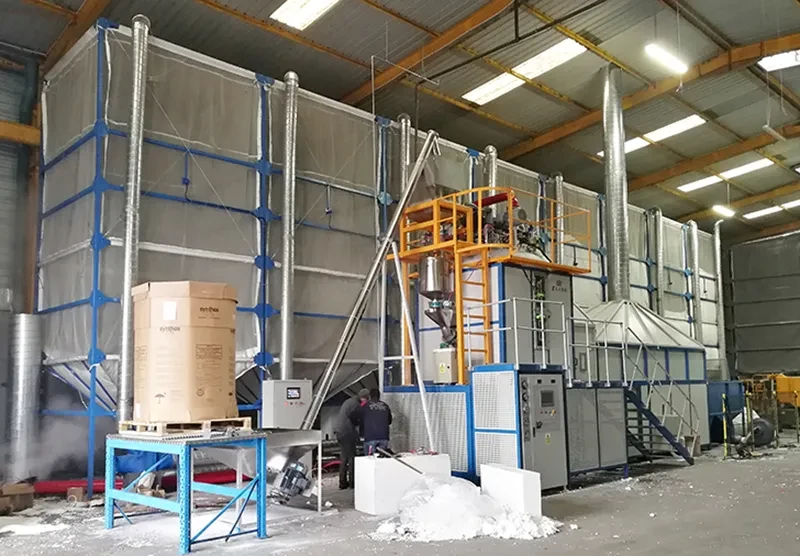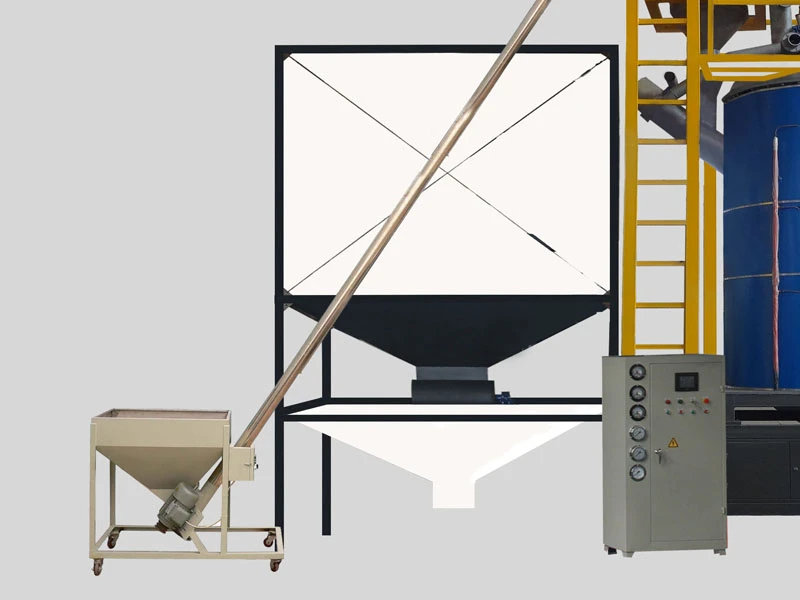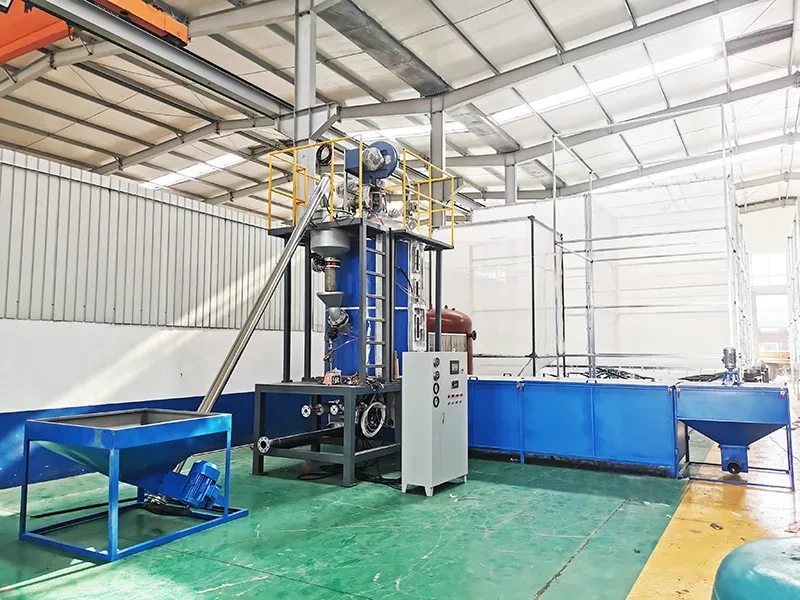Hello, my name is Allen. As a machine manufacturer from China with over two decades of experience in the EPS and EPP industry, I’ve seen the evolution of foam production firsthand. At exhibitions around the world, I often speak with decisive business owners like Mark Thompson from the USA. They’re not just looking for an eps machine; they’re looking for a reliable partner and a competitive edge. They understand that the quality of their final product—be it packaging, insulation, or custom shapes—begins with the very first step: the expansion of the raw polystyrene beads.
This is where the EPS Pre-expander machine comes in. It is, without a doubt, the heart of any successful EPS production line. Getting this stage right is non-negotiable. This guide is built from my years on the factory floor. It’s designed to demystify the pre-expansion process, help you understand the critical differences between batch and continuous models, and empower you to choose the right machinery to boost your production efficiency and product quality.
What is an EPS Pre-Expander Machine and Why is it the Heart of Your Foam Production?
In the world of polystyrene machine technology, the pre-expander is where the transformation begins. This specialized expander machine takes tiny, solid polystyrene beads—the EPS raw material—and transforms them into the lightweight, expanded foam beads that are the building blocks of every Styrofoam product. The machine uses precisely controlled steam to heat the beads, causing the pentane (a blowing agent) inside each bead to vaporize and expand. This process can increase the volume of each bead by up to 50 times.
Calling it the "heart" of the eps production line is no exaggeration. The characteristics of the expanded beads—their size, density, and moisture content—are all determined in this crucial stage. If the beads are improperly expanded, no amount of work by the downstream molding machine can fix it. Inconsistent density will lead to weak spots in an EPS block, poor surface finish on an EPS shape, and ultimately, a failed product. A high-quality, reliable EPS pre-expander machine ensures you start with a consistent bead material, giving you the foundation needed for a smooth and efficient production process from start to finish.
How Does the Polystyrene Bead Expansion Process Actually Work?
The process seems like magic, but it’s pure science and engineering. It all happens inside a sealed chamber within the expander machine. First, a pre-determined weight of raw virgin EPS beads is fed into the chamber. Once the chamber is sealed, steam is injected through a series of valves. The steam’s heat and pressure do two things simultaneously: they soften the polymer structure of the polystyrene and heat the blowing agent inside each bead.
As the blowing agent turns into a gas, it pushes outwards, inflating the softened bead like a tiny balloon. The operator controls this expansion by managing the steam pressure and the duration of the cycle. A higher steam pressure or a longer cycle time will result in a lower density (more expanded) bead. Once the target density is reached, the steam is shut off, and the newly expanded foaming beads are agitated and cooled before being discharged into a drying bed and then conveyed to a storage silo to age. This aging process is vital, as it allows the beads to stabilize and dry before the next stage of molding.
Batch Pre-Expander vs. Continuous Pre-Expander Machine: Which is Right for You?
One of the first decisions a producer faces is choosing between a batch pre-expander and a continuous pre expander. The right choice depends entirely on your production needs, the variety of products you make, and your required throughput. As a machinery manufacturer, I help clients make this choice every day.
A Batch Pre-Expander Machine processes the polystyrene beads in distinct, separate cycles or "batches." It is incredibly versatile and offers precise control over the final density. This makes it the ideal choice for businesses that produce a wide range of products requiring different foam densities, such as custom packaging or specialized technical parts.
A Continuous Pre-Expander Machine, on the other hand, is designed for high-volume, single-density production. The raw bead material is fed in one end and expanded beads flow out the other in a constant stream. This machine eps model is perfect for large-scale operations that produce the same product day in and day out, like standard insulation boards or high volumes of block molding.
Here’s a simple breakdown:
| Feature | Batch Pre-Expander | Continuous Pre-Expander Machine |
|---|---|---|
| Flexibility | High: Excellent for frequent density changes. | Low: Optimized for a single, consistent density. |
| Density Control | Very Precise: Uses weighing systems for exact input. | Less Precise: Relies on volumetric feeding. |
| Throughput | Lower to Medium | High to Very High |
| Ideal For | Custom shape molding, multiple product lines, high-quality requirements. | Block molding, insulation board production, high-volume manufacturing. |
| Footprint | Generally smaller. | Larger, requires more space. |
What are the Key Components of a High-Quality Batch Pre-Expander?
When a customer like Mark evaluates a batch eps pre-expander machine, he’s looking for reliability and precision. From my perspective, these qualities come from the quality of the components. A modern eps auto batch pre-expander is a symphony of coordinated parts. The main expansion chamber is typically made of stainless steel for durability and corrosion resistance. Inside, a robust agitator keeps the eps beads moving to ensure uniform heating.
The steam system is critical. It includes high-quality pressure-reducing valves and angle seat valves to deliver steam at the exact pressure required. But the real precision comes from the control systems. A high-quality machine styrofoam batch expander machine will feature an electronic weighing system to measure the raw material for each batch precisely. This is far more accurate than older volume-based methods. Additionally, advanced sensors, such as a material level control system, monitor the process in real-time, ensuring each batch is identical to the last. This level of automation and precision is what separates a basic foam machine from a truly professional piece of equipment.

Why is Precise Density Control So Crucial in an EPS Batch Pre-Expander?
Density is the single most important property of expanded polystyrene. It dictates the physical characteristics of the final product: its compressive strength, its insulating value (R-value), and its weight. In a batch pre-expander, achieving the exact target density is paramount. If you are producing protective packaging for a delicate electronic device, the foam must have a specific density to absorb impact correctly. If you’re making lost foam patterns for metal casting, the density must be perfect to ensure the pattern vaporizes cleanly.
This is why the electronic weighing system in an eps batch pre expander is so important. By measuring the weight of the raw EPS beads for each cycle, the machine can guarantee that the input material is always the same. When combined with precise steam control, this allows the operator to produce beads with consistent density batch after batch. This consistency is what allows a high-quality molding machine to produce perfect parts. Without it, you would face constant quality issues, material waste, and production delays.
How Does a Continuous EPS Pre-Expander Machine Boost Production Efficiency?
For businesses focused on high-volume manufacturing, the continuous pre-expander machine is an efficiency powerhouse. Its main advantage is its uninterrupted operation. Unlike a batch expander machine eps pre-expander that runs in cycles, a continuous eps expander machine runs constantly, delivering a steady stream of expanded beads. This is ideal for feeding a large-scale EPS block molding machine that consumes a huge amount of material.
The process is automated and streamlined. Raw polystyrene beads are fed into the machine via a screw conveyor at a constant rate. Steam is continuously injected, and the expanded beads are continuously discharged. This design eliminates the cycle time associated with batch processing, leading to a much higher hourly output. While it offers less flexibility for changing densities, its ability to improve production efficiency for a single-density product line is unmatched. This makes the eps continuous pre-expander machine the workhorse of the styrofoam insulation and block production industry.

What Role Does the PLC and Touch Screen Play in a Modern Expander Machine?
The days of manual adjustments and guesswork are long gone. Modern pre-expanders are controlled by a PLC (Programmable Logic Controller) and an intuitive touch screen interface. The PLC is the machine’s brain, a rugged industrial computer that manages every aspect of the expansion cycle with split-second timing. The PLC and touch screen system allows the operator to easily set, monitor, and save all the crucial parameters.
This technology is what makes a machine like our EPS Pre-expander Machine so reliable and user-friendly. An operator can create and save recipes for different densities. With the push of a button, the machine will automatically load the correct weight of material, control the steam valve, manage the expansion time, and discharge the finished beads. The machine adopting programmable logic controller technology minimizes the chance of human error, reduces reliance on highly skilled operators, and ensures that the product quality is consistent from the first batch of the day to the last. This is a critical feature for any modern foam production facility.
From Virgin EPS to Final Product: Integrating the Pre-Expander into Your Production Line
The expander machine is the first step, but it’s part of a larger, integrated system. After the virgin eps beads are expanded, they are transferred to large aging silos. Here, they cool, stabilize, and dry for several hours. This aging period is essential for achieving good fusion in the next stage.
From the silos, the expanded beads are pneumatically conveyed to the molding machine. This could be a large EPS Block Moulding Machine that fuses the beads into massive blocks of eps foam. These blocks are then cured before being sliced by an eps cutting machine into sheets for construction insulation or other applications. Alternatively, the beads can be sent to an EPS Shape Moulding Machine to create complex, custom products like helmets, packaging corners, or flotation devices. A well-designed eps production facility ensures a smooth, automated flow of material from the pre-expander all the way to the final product.

Choosing the Right China EPS Pre-Expander Machine Manufacturer: What to Look For?
For a buyer in the USA or Europe, sourcing machinery from overseas can be daunting. Mark’s pain points—communication, delivery, and support—are all too common. As a China eps manufacturer committed to the global market, I believe transparency and partnership are key. When you’re choosing a supplier, look beyond the price tag.
First, look for a true machinery manufacturer, not just a trading company. A manufacturer has deep technical knowledge, controls the quality of their own production, and can provide long-term support. Second, evaluate their communication. Do they have a professional, English-speaking sales and technical team that can clearly answer your questions? Third, ask about after-sales support. What is their warranty policy? Do they provide installation and training? How quickly can they supply spare parts like valves or control components? A reputable supplier will have clear, confident answers to these questions. They should be a partner invested in your success, not just a vendor selling you a box.
Common Mistakes to Avoid When Operating Your EPS Pre-Expander Machine
Even the best machine eps pre-expander machine styrofoam can produce poor results if not operated correctly. Over the years, I’ve seen a few common mistakes that can easily be avoided.
- Skipping the Aging Process: The most common error is rushing the expanded beads from the expander machine directly to the molding machine. The beads need time to stabilize. Skipping this step results in poor fusion, shrinkage, and weak products.
- Using Wet Steam: The quality of your steam is critical. Wet steam (steam with too much water content) will not expand the polystyrene beads properly and will leave them with excessive moisture. This leads to longer cycle times and poor-quality foam.
- Ignoring Maintenance: A pre-expander machine has moving parts, valves, and filters that need regular cleaning and inspection. Neglecting routine maintenance can lead to inconsistent performance and costly breakdowns.
- Improper Material Storage: EPS raw material should be stored in a cool, dry place. Storing it in a hot environment can cause the blowing agent to escape prematurely, leading to poor expansion.
By avoiding these simple mistakes and investing in a fully automatic, high-quality expander machine, you can ensure your foam production process starts on the right foot, every single time.
Post time: 10-10-2025





